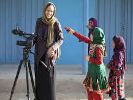Eye For Film >> Movies >> Frame By Frame (2015) Film Review
Frame By Frame
Reviewed by: Jennie Kermode

Watch a film like 1987's The Living Daylights and you'll see an Afghanistan that has disappeared from cinema screens, one in which the local people are heroes and natural allies to Hollywood protagonists. Fast forward 14 years and Afghanistan, ruled by the Taliban since 1996, was suddenly the enemy of the West. Its heroes gave way to stock bad guys, filling in the gap in action movies that the Nazis and Soviets had vacated, but perhaps more striking than this was the utter disappearance of stories from inside the country. As its image has faded, Afghanistan has become an object fought over by other people, a country without a voice.
In this context, the arrival of a film consisting wholly of Afghan voices is something special. The people we meet in this documentary are among the first generation of journalists to be trained after the Soviet war. they've been at work for some years now and although their work has filtered through into the international media, there has been little media focus on them as subjects - on the massive risks they take and the importance of their work to their country's future. Here they are able to speak for themselves about what they do, why they do it and what it means.

The first thing you'll notice about he images in the film is that they differ starkly from those in most Western media. Yes, there are dusty deserts, impoverished villages and old men in ragged clothes, but there are also shining city centres where the people look no different from those you might see in London or New York; there are the same concrete housing estates found in half the cities in the UK; in the newspaper offices, business is conducted as it would be anywhere else. The country is straining away from its troubled history. It might be building a bright new future - or this might be a temporary peace. The international armed forces are leaving. The Taliban are expected to return "in some form". Nobody knows what that form will be, or how much resistance they will meet.
The film follows four photojournalists, each focused on a different subject. Massoud captures images of daily life, but it is the images of conflict emerging from this work that have won him international attention, the picture of a young girl surrounded by dead bodies that won him a Pulitzer prize. Farzana, his wife, specialises in photographing girls and women, something which was forbidden under Taliban rule, and thus revealing the issues that dominate their lives. Wakil captures the stories of drug addicts and the destitute, casualties of the politically motivated shift from opium, which had been used fairly harmlessly for thousands of years, to heroin, whose impact users were completely unprepared for. Then there's Najibullah, who teaches photography, skilling up a generation of young people keen to record and share and preserve everything they can in the world around them.
There are powerful elements to all these stories, and even though the structure of the film is fairly formulaic it opens a window onto worlds rarely glimpsed from outside. Farzana's work, in particular, reveals not only how much damage was done by the Taliban - she herself recalls being beaten in the street for having an uncovered face at the age of 13 - but the damage still being done today. A generation of women has been denied even primary level education, severely limiting their prospects. Violent abuse of women is ongoing in many contexts, with little recourse. At a hospital ward for victims of self-immolation (some of whom may in fact have been set on fire by others), she is turned away by a doctor who fears that if she takes pictures there, he will be killed.
It's an ethical minefield. Some of those women might want to tell their stories, Farzana says. It should be their decision. The driving ethos behind her work is giving people a voice.
Reviewed on: 06 Feb 2016

















